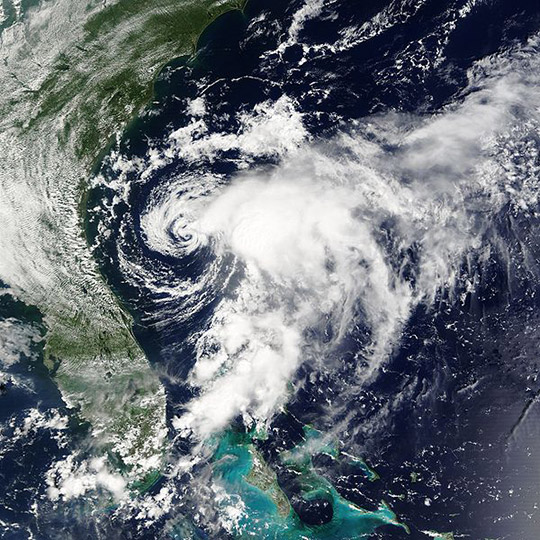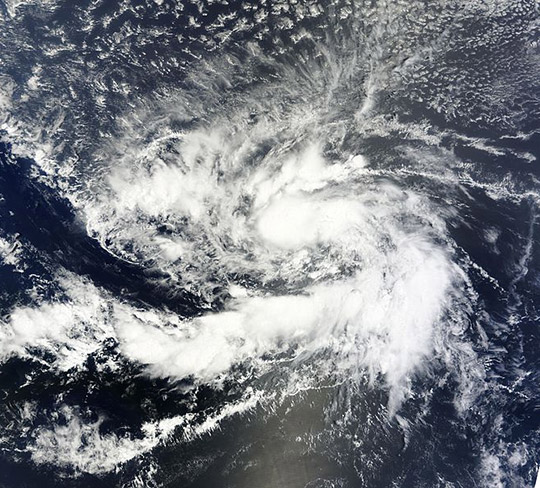Tropical Storm

Source: Tropical Storm Edouard 2002 | Wikimedia
A tropical cyclone in which the maximum 1-minute sustained surface wind ranges from 34 to 63 knots (39 to 73 mph) inclusive.
A tropical cyclone is a rotating, organized system of clouds and thunderstorms that originates over tropical or subtropical waters and has a closed low-level circulation. Depending on location, tropical cyclones have different names around the world. In the Atlantic/Eastern Pacific Oceans they are called hurricanes. Click on the symbols on the map to find out more information about the different classifications of tropical cyclones in the Atlantic Basin.
Copyright © 2017. WeatherSTEM. All Rights Reserved.

Source: Tropical Storm Edouard 2002 | Wikimedia
A tropical cyclone in which the maximum 1-minute sustained surface wind ranges from 34 to 63 knots (39 to 73 mph) inclusive.

Source: Hurricane Katrina August 28 2005 NASA | Wikimedia
A tropical cyclone in the Atlantic, Caribbean Sea, Gulf of Mexico, or eastern Pacific in which the maximum 1-minute sustained surface wind is 64 knots (74 mph) or greater.

Source: Tropical Depresssion Fourteen | Wikimedia
A tropical cyclone in which the maximum 1-minute sustained surface wind is 33 knots (38 mph) or less.
A tropical disturbance is the first state of the development of a hurricane. It ismade up of areas of unsettled weather and thunderstorms. These systems have onlya slight wind circulation. Tropical disturbances commonly exist in areas near the tropical trade winds and are often accompanied by clouds and precipitation.
74 – 95 mph: Very dangerous winds will produce some damage.
96 – 110 mph: Extremely dangerous winds will cause extensive damage.
111 – 130 mph: Major Hurricane: Devastating damage will occur.
131 – 155 mph: Major Hurricane: Catastrophic damage will occur.
< 155 mph: Major Hurricane: Catastrophic damage will occur.

Source: Tropical Storm Edouard 2002 | Wikimedia
Tropical depressions are upgraded to tropical storm status once they contain sustained winds of 39 mph or greater. At this point, the system is assigned a name. The rotation of a tropical storm is more recognizable as a distinct “spin” in the atmosphere. Although tropical storms do not have very high winds, they are still capable of producing floods and even tornadoes!

Source: Hurricane Katrina August 28 2005 NASA | Wikimedia
Tropical storms are upgraded to hurricane status once they contain sustained winds of 74 mph or greater. Hurricanes are one of the most severe types of weather and have a very pronounced rotation. Depending on the strength of the storm, some hurricanes develop an “eye” that marks the center of the hurricane’s rotation. Under the right circumstances, hurricanes can sustain themselves for a couple of weeks.

Source: Tropical Depresssion Fourteen | Wikimedia
Designated at the first appearance of a lower pressure area and organized circulation in a center of a group of thunderstorms. Tropical Depressions usually have winds of 25-38 mph.

Source: Tropical Storm Edouard 2002 | Wikimedia
Tropical depressions are upgraded to tropical storm status once they contain sustained winds of 39 mph or greater. At this point, the system is assigned a name. The rotation of a tropical storm is more recognizable as a distinct “spin” in the atmosphere. Although tropical storms do not have very high winds, they are still capable of producing floods and even tornadoes!

Source: Hurricane Katrina August 28 2005 NASA | Wikimedia
Tropical storms are upgraded to hurricane status once they contain sustained winds of 74 mph or greater. Hurricanes are one of the most severe types of weather and have a very pronounced rotation. Depending on the strength of the storm, some hurricanes develop an “eye” that marks the center of the hurricane’s rotation. Under the right circumstances, hurricanes can sustain themselves for a couple of weeks.

Source: Tropical Depresssion Fourteen | Wikimedia
Designated at the first appearance of a lower pressure area and organized circulation in a center of a group of thunderstorms. Tropical Depressions usually have winds of 25-38 mph.